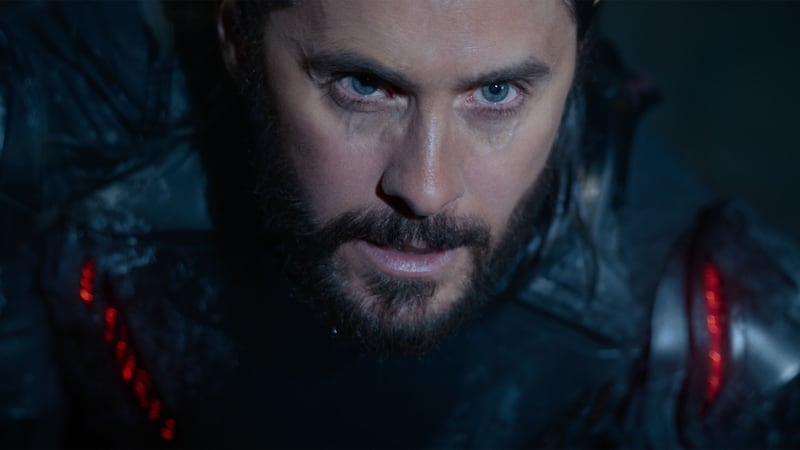Tron has always been a style-over-substance franchise.
Its narrative gobbledygook about digital realms—which has only grown more outdated and nonsensical since the initial 1982 film—was overshadowed by its arresting computerized imagery of light cycles, disc warfare, and microchip-esque architecture and armor designs.
Four-plus decades after its debut, its legacy is one of vehicles and weapons leaving glowing red and blue light trails in their wake; of helmeted men and women flipping and leaping over deadly glowing frisbees; and of cutting-edge sound and fury that dazzles the eye and rattles the chest. Memorable if thin, it’s a showcase for state-of-the-art techno-aesthetics married to stories that are so convoluted and underwhelming as to be inconsequential.
For its first new chapter in 15 years, the franchise remains true to form with Tron: Ares. The reboot-y sequel does little to upgrade the stunning visual revamp of 2010’s Tron: Legacy, but nonetheless provides plenty of IMAX-grade spectacle.
Greatly enhanced by an original Nine Inch Nails soundtrack (from Oscar-winning composers/executive producers Trent Reznor and Atticus Ross), Joachim Rønning’s film, in theaters Oct. 10, plays things a tad straighter than its predecessors, falling back on conventional character and plot dynamics for its tale about the dawning consciousness of a warrior A.I..
Moreover, it makes a not-inconsiderable misstep by relocating much of its action from the computer to the real world—a decision that undercuts the series’ transportive fantasy. Still, in an age of bland, unimaginative cookie-cutter blockbusters, there’s something refreshing about a movie that puts a premium on looking and sounding bada–.

Despite its title, Tron: Ares does not feature the character Tron, who goes unmentioned during its entire two hours. It does, however, boast Ares (Jared Leto), the “master control” program of the virtual-reality Grid invented by Dillinger Systems, whose CEO Julian (Evan Peters) is a sniveling tyro villain straight out of central casting.
Julian can create anything in the Grid—which resembles a sci-fi city and is populated by humanoid programs—and beam it to our reality, and he plans on using this tech to make a fortune selling weapons and soldiers (that can be endlessly resurrected) to the military.
The problem is that his digital constructs only last for 29 minutes before disintegrating (a process known as “de-resolution”). Thus, he’s in a race to find the “permanence code” with his rival Eve Kim (Greta Lee), who’s taken over ENCOM from Sam Flynn (Garrett Hedlund), the protagonist of Tron: Legacy and the son of founder Kevin Flynn (Jeff Bridges)—all as she mourns the death of her sister and partner Tess.

Dillinger’s Grid is color-coded red because it’s as evil as its maker, and its “defender” is Ares, an unstoppable security protocol (“the ultimate soldier”) who, during a presentation by Julian to investors, proves fascinated by fireflies and the rain—early hints that he’s destined to bristle at his maker’s belief that he’s “expendable.”
Like infinite inorganic cinematic beings before him, Ares wants to live. His desire for free will is the driver of Tron: Ares, whose story kicks into gear when Eve discovers the permanence code on Kevin’s old server and is promptly hunted by Ares and his second-in-command Athena (Jodie Turner-Smith) on the orders of Julian, who—no matter his mom Elisabeth’s (Gillian Anderson) warnings—will stop at nothing to crush his competition.

While Tron: Ares occasionally takes place in the Grid, most of it is set in a glittering unnamed city where Ares and Athena speed and fly about in sleek, radiant rides that far outpace man’s traditional motorcycles and fighter jets. This change of venue certainly distinguishes the film from its ancestors. Yet as with the Jurassic World series, the novelty quickly wears off and what’s left is an Earthbound saga that’s less about exploration and discovery than about invasion and mayhem.
The contrast between these two disparate (if connected) universes occasionally pays dividends, as with the sight of Athena, manning a fearsome light jet, hovering outside a high-rise office window. Those moments, though, can’t quite quell the nagging desire to spend additional time in the Grid, which is the franchise’s entire selling point.

Fortunately, Rønning’s rollercoaster camerawork and propulsive pacing keep Tron: Ares on a reasonably steady track, as do centerpieces that have a striking synthetic sheen.
From a formal standpoint, the film doesn’t significantly build upon Joseph Kosinski’s prior outing, but its showmanship is impressive, aided by thunderous NIN compositions which jolt the material with cacophonous urgency. Reznor and Ross’ roaring waves of industrial metal are perfectly in sync with Rønning’s grand panoramas of illuminated skylines and pixelated lakes, and their contributions alone do much to make this threequel a sensory feast worth experiencing on the biggest multiplex screen available.
There’s nothing much, alas, beneath Tron: Ares’ hood, as Jess Wigutow’s script is a familiar hodgepodge of swift set pieces interspersed with one-note conversations about artificial intelligence (it’s scary! Except, you know, maybe not!), autonomy, and compassion. Throughout his odyssey, Leto’s Ares reveals that he’s more than just 0s and 1s by admitting that he prefers Depeche Mode to Mozart (they’re “deeply invigorating”), and he ultimately visits a nostalgic 1980s-style Grid where Bridges’ Kevin smiles with pride about the ‘bot’s musical taste and, also, his reliance on “feelings” over logic (“Very good, man!”).

Peters maniacally screams and fumes, Lee runs around, and Turner-Smith glowers as a program who, unlike Ares, isn’t comfortable disobeying directives. They’re all 8-bit types, and Ares’ transformation from bad to good guy is so preordained that it makes no impact—except, that is, during a coda in which he gets to let his long locks flow and the film finally embraces its cheesier impulses.
Tron: Ares takes no side in the ongoing debate about the role of artificial intelligence in society and filmmaking except to say that in the right hands, it could be a paradigm-shifting benefit; mostly, it’s content to employ its advanced tools for electro-razzle-dazzle. In that regard, Rønning and company have merely applied a fresh coat of new-school paint to an old-school slam-bang template. Yet as far as shiny 21st-century extravaganzas go, it’s got enough CGI processing power to suggest that a future update might be a worthwhile endeavor.
The post ‘Tron: Ares’ Is an Electric Feast of Music, Effects, and Jared Leto’s Hair appeared first on The Daily Beast.




